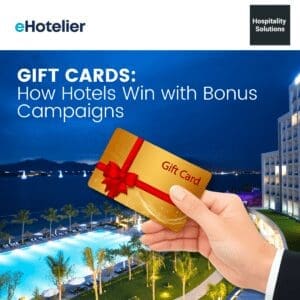Food and beverage is an area of hospitality that I consider integral and yet it comes with a lot of unpredictability. That’s why it’s always good to hear from current and former F&B Directors to decipher how they managed and succeeded in this volatile field.
To this end, I’ve recruited Sean Handerhan – a former Director of Food and Beverage Marketing at Marriott for 17 years – for a discussion on the topic. Of note during his tenure, Sean helped implement the first branded pizza program for this chain as well as initiating the development of The Gourmet Bean, a multifaceted coffee concept that has been installed in over 100 locations. Throughout this time, Sean has led multi-discipline teams to improve hotel restaurant operations by applying customer research, developing facility layout changes and redeploying staff to heighten guest satisfaction scores.
Why is F&B often labeled as the least profitable segment of the business?
Each of the components has more variable cost components than other areas of a lodging facility. Food costs can vary greatly over a relatively short period of time. Demand for the services (in restaurants and bars) is usually more unpredictable than rooms operations and therefore results in higher than ideal labor costs.
With rare exceptions, F&B is viewed as something of a costly amenity – something that is necessary in a hospitality operation, rather than a free-standing, locally-focused enterprise. Frequently this area lacks a defined plan of what the F&B operations should be – who are the customers and what is the competition? A well conceived plan will help identify ways to be more efficient with both labor and food cost without sacrificing quality or brand position.
Is there a way to look at F&B systematically to quantify lagging areas?
Most definitely, and that is what the G7 Food and Beverage Road Map is designed to do. Our approach is a structured one that looks at the operation as a whole, the market in which it operates and its business potential. Plus, this system determines realistic, prioritized solutions that can be executed without extensive capital investment.
How do accountability and responsibility come into play?
We look for instances where labor is being deployed inefficiently, including the level of support and supervision that is provided by management. Generally, it is not realistic to assume an F&B operation in our client’s properties can operate with a hierarchical management structure. The key is to define a flatter team structure, and then use the tools in place to push responsibility, authority and accountability to the front-line staffers, while also giving them a vested interest in the performance of the business.
How do you develop a program that quantifies service excellence?
The simplest answer is in covers and customers. We’d suggest that excellence is best defined as customer satisfaction and perceived value for the money – rather than elaborate fussy service procedures. In order to model service excellence over time, training processes and educational support must evolve, plus be regular and ongoing. Better-trained staff should be able to sell the products better and in doing so, create a win-win for the client and the customer.
What about staffing, menu design and job responsibilities?
It starts with a realistic assessment of the optimum potential from the existing physical plant. That helps dictate what limits are placed on the menu. Next, what is the ability of the staff to learn multiple functions? This breaks down barriers that may currently exist. It is important that there is shared responsibility and accountability between the front and back of house teams.
Give us a case study of where you have seen marked improvements in F&B profitability through a comprehensive focus on these fundamentals.
Often we see menu creep, denoting when the scope of a menu keeps growing and yet nobody steps back to look at the whole to ensure that it reflects the intent, potential and viability of an outlet. There was one instance where my client had two outlets side-by-side, both serving virtually the same menu yet one had a food orientation and the other beverage. I closed one and combined the parts into a more dynamic space, which we could then afford to redo. The empty space is now on the market to lease out and the costs to ‘open the door’ in the second outlet have been eliminated.
I can also share a case in which we focused on the breakfast meal period as it was the most important meal for the transient guests in the hotel. We spent a week sitting in the restaurant at various times throughout the morning to observe the roles staff and management played. We found the outlet had become buffet driven to lower labor costs, but the waste and quality of the food had gotten out of line. There were hosts who seated customers but didn’t facilitate taking their orders. We found service staff spending too much time in the kitchen doing cold food prep and therefore unavailable to guests. We found coffee poured into thermoses and placed on the tables at the beginning of the shift because coffee couldn’t be made in small batches.
Our solution? We eliminated the host positions and encouraged wait staff, with manager guidance, to seat the customers to facilitate an earlier ordering process. We instituted a pager system that called the service staff to the back when their food was ready. We worked with our coffee supplier to provide new brewing equipment and station it in the restaurant. We moved kitchen staff to act as an omelet chef on the buffet, who produced more food to order and reduced food waste from uneaten buffet food in chafing dishes. The result was lower food cost, better food quality, quicker service and food staff cooking the food instead of service staff.
About the author
Larry Mogelonsky (larry@lma.net) is the president and founder of LMA Communications Inc. (www.lma.ca), an award-winning, full service communications agency focused on the hospitality industry (est. 1991). Larry is also the developer of Inn at a Glance hospitality software. As a recognized expert in marketing services, his experience encompasses Four Seasons Hotels & Resorts and Preferred Hotels & Resorts, as well as numerous independent properties throughout North America, Europe and Asia. Larry is a registered professional engineer, and received his MBA from McMaster University. He’s also an associate of G7 Hospitality, a member of Cayuga Hospitality Advisors and Laguna Strategic Advisors. Larry’s latest anthology book entitled “Llamas Rule” and his first book “Are You an Ostrich or a Llama?” are available at Amazon and Barnes & Noble.
This article may not be reproduced without the expressed permission of the author.















